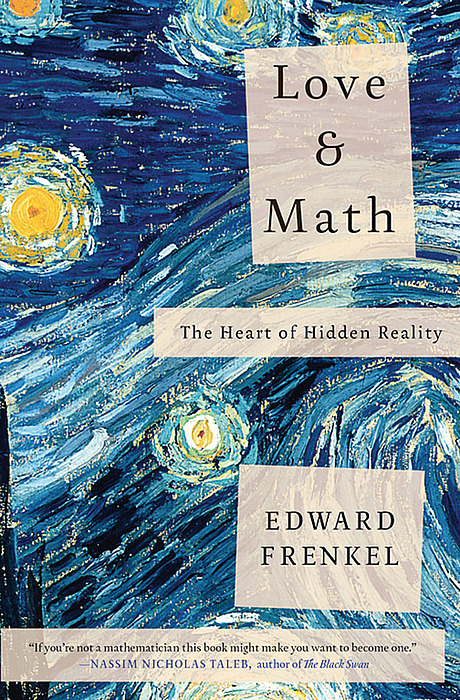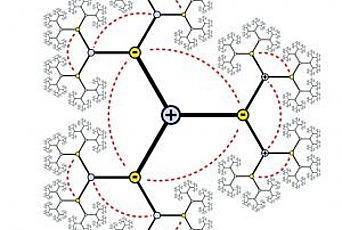Love and Math: The Heart of Hidden Reality

The Institute for Advanced Study has played an important role in my academic life. I have fond memories of my first visit in 1992, when, a starstruck kid, I was invited by Gerd Faltings and Pierre Deligne to talk about my Ph.D. thesis, which I had just completed. In 1997, I spent a whole semester at the IAS during a special year on quantum field theory for mathematicians. I returned to the IAS on multiple occasions in 2007 to collaborate with Edward Witten, and then in 2008–09 to work with Robert Langlands and Ngô Bao Châu.
Perhaps one of the most memorable visits was the one that happened exactly ten years ago, in March of 2004. It is described below in the (slightly abridged) excerpt from my book Love and Math. A few months earlier, Kari Vilonen, Mark Goresky, Dennis Gaitsgory, and I were chosen to receive a multimillion dollar grant from the Defense Advanced Research Projects Agency (DARPA) to work on a project aimed at establishing links between the Langlands program and dualities in quantum field theory. We felt like we were in uncharted territory: no mathematicians we knew had ever received grants of this magnitude before. Normally, mathematicians receive relatively small individual grants from the National Science Foundation. Here we were given a lot of resources to coordinate the work of dozens of mathematicians with the goal of making a concerted effort in a vast area of research. This sounded a bit scary, but the idea of surpassing the traditional, conservative scheme of funding mathematical research with a large injection of funds into a promising area was really exciting, so we could not say no. We turned to the Institute for Advanced Study as the place to foster innovation. As they say, the rest is history.
______________________
In a stroke of luck, Peter Goddard, one of the physicists who discovered the electromagnetic duality in non-abelian gauge theories, was about to become the Director of the Institute for Advanced Study in Princeton. His more recent research was on things related to representation theory of Kac–Moody algebras, and because of this, I had met Peter at various conferences.
In my email to Peter, I told him about our DARPA grant and suggested that we organize a meeting at the Institute for Advanced Study to bring together both physicists and mathematicians to talk about the Langlands program and dualities in physics, to try to find common ground, so that we could solve the riddle together.
Peter’s response was the best we could hope for. He offered his full support in organizing the meeting.
The Institute was a perfect venue for such a meeting. Created in 1930 as an independent center of research and thinking, it has been home to Albert Einstein (who spent the last twenty years of his life there), Andrè Weil, John von Neumann, Kurt Gödel, and other prominent scientists. The current faculty is equally impressive: it includes Robert Langlands himself, who has been a professor there since 1972 (now emeritus), and Edward Witten. Two other physicists on the faculty, Nathan Seiberg and Juan Maldacena, work in closely related areas of quantum physics, and several mathematicians, such as Pierre Deligne and Robert MacPherson, conduct research on topics linked to the Langlands program.
My email exchange with Goddard resulted in plans for an exploratory meeting in early December 2003. [DARPA Program Director] Ben Mann, Kari Vilonen, and I were coming to Princeton, and Goddard promised to participate. We invited Witten, Seiberg, and MacPherson; another Princeton mathematician, Mark Goresky, who was co-managing the DARPA project with Kari and myself, was to join us as well (we also invited Langlands, Maldacena, and Deligne, but they were traveling and could not attend).
The meeting was set to start at 11 a.m. in the conference room next to the Institute cafeteria. Ben, Kari, and I arrived early, about fifteen minutes before the meeting. There was no one else there. As I was pacing nervously around the room, I couldn’t stop thinking: “Is Witten coming?” He was the only one of the invitees who had not confirmed his participation.
Five minutes before the meeting, the door opened. It was Witten! That was the moment when I knew that something good would come out of all this.
A few minutes later, the other participants arrived. We all sat around a big table. After the usual greetings and small talk, there was silence.
“Thank you all for coming,” I began. “It has been known for some time that the Langlands program and electromagnetic duality share something in common. But the exact understanding of what’s going on has eluded us, despite numerous attempts. I think the time has come to unravel this mystery. And now we have the necessary resources because we have received a generous grant from DARPA to support research in this area.”
People at the table were nodding their heads. Peter Goddard asked, “How do you propose we go about it?”
Prior to the meeting, Kari, Ben, and I played out different scenarios, so I was well prepared.
“I suggest that we organize a meeting here at the Institute. We will invite physicists working in related areas and we will organize lectures by mathematicians to present our current state of knowledge in the Langlands program. We will then discuss together possible links to quantum physics.”
Now all eyes turned to Witten, the dean of quantum physicists. His reaction was crucial.
Tall and physically imposing, Witten projects great intellectual power, to the point where some feel intimidated by him. When he speaks, his statements are precise and clear to a fault; they seem to be made of unbreakable logic. He never hesitates to take a pause, contemplating his answer. At such times, he often closes his eyes and leans his head forward. That’s what he did at that moment.
All of us were waiting patiently. Less than a minute must have passed by, but to me it felt like eternity. Finally, Witten said, “This sounds like a good idea. What dates do you have in mind for the meeting?”
Ben, Kari, and I couldn’t help but look at each other. Witten was on board, and this was a big victory for us.
After a brief discussion, we found the dates that were suitable for everyone: March 8–10, 2004. Then someone asked who would be the participants and the speakers. We mentioned a few names and agreed to finalize the list over email and send the invitations shortly. At this, the meeting adjourned. It took no more than fifteen minutes.
Needless to say, Ben, Kari, and I were very pleased. Witten promised to help organize the meeting (which would of course be a big draw for the invitees) and to actively participate in it as well. We also expected that Langlands would take part, as well as other physicists and mathematicians on the Institute faculty who were interested in the subject. Our first goal was accomplished.
In the course of the next few days we finalized the list of participants, and a week later invitations went out. Normally, conferences like this have fifty to a hundred participants. What often happens is that speakers give their talks while everyone listens politely. A couple of participants might ask questions at the end of the talk, and a few more may engage the speaker afterward. We envisioned something completely different: a dynamic event that was more a brainstorming session than a typical conference. Therefore we wanted to have a small meeting, about twenty people. We hoped that this format would encourage more interaction and free-wheeling conversation between participants.
______________________
Just about an hour by train from New York City, Princeton looks like a typical Northeastern suburban town. The Institute for Advanced Study, known in the scientific community simply as “The Institute,” is on the outskirts of Princeton, literally in the woods. The area around it is quiet and picturesque: ducks swimming in small ponds, trees reflected in still water. The Institute, a cluster of two- and three-story brick buildings with the feel of the 1950s, radiates intellectual power. One can’t help but savor its rich history wandering in the hushed corridors and the main library, which was used by Einstein and other giants.
This is where we had our meeting in March 2004. Despite the short notice, the response to the invitations we sent in December was overwhelmingly positive. There were about twenty participants—so when I opened the meeting, I asked those present to take turns and introduce themselves. I felt like pinching myself: Witten and Langlands were there, sitting close by, as was Peter Goddard—and several of their colleagues from both the School of Mathematics and the School of Natural Sciences. David Olive, of the Montonen–Olive and Goddard–Nuyts–Olive papers, was also present. And of course Ben Mann was with us as well.
Everything went according to plan. We were essentially recounting the story that you have been reading in this book: the origins of the Langlands program in number theory and harmonic analysis, the passage to curves over finite fields and then to the Riemann surfaces. We also spent quite a bit of time explaining the Beilinson–Drinfeld construction and my work with Feigin on Kac–Moody algebras, as well as its links to the two-dimensional quantum field theories.
Unlike a typical conference, there was a lot of give and take between the speakers and the audience. It was an intense meeting with discussions continuing from seminar room to cafeteria and back.
Throughout, Witten was in high gear. He was sitting in the front row, listening intently and asking questions, constantly engaging the speakers. On the morning of the third day, he said to me, “I’d like to speak in the afternoon; I think I have an idea what’s going on.”
After lunch, he gave an outline of a possible connection between the two subjects. This was the beginning of a new theory bridging math and physics, which he and his collaborators, and then many others, have been pursuing ever since.


